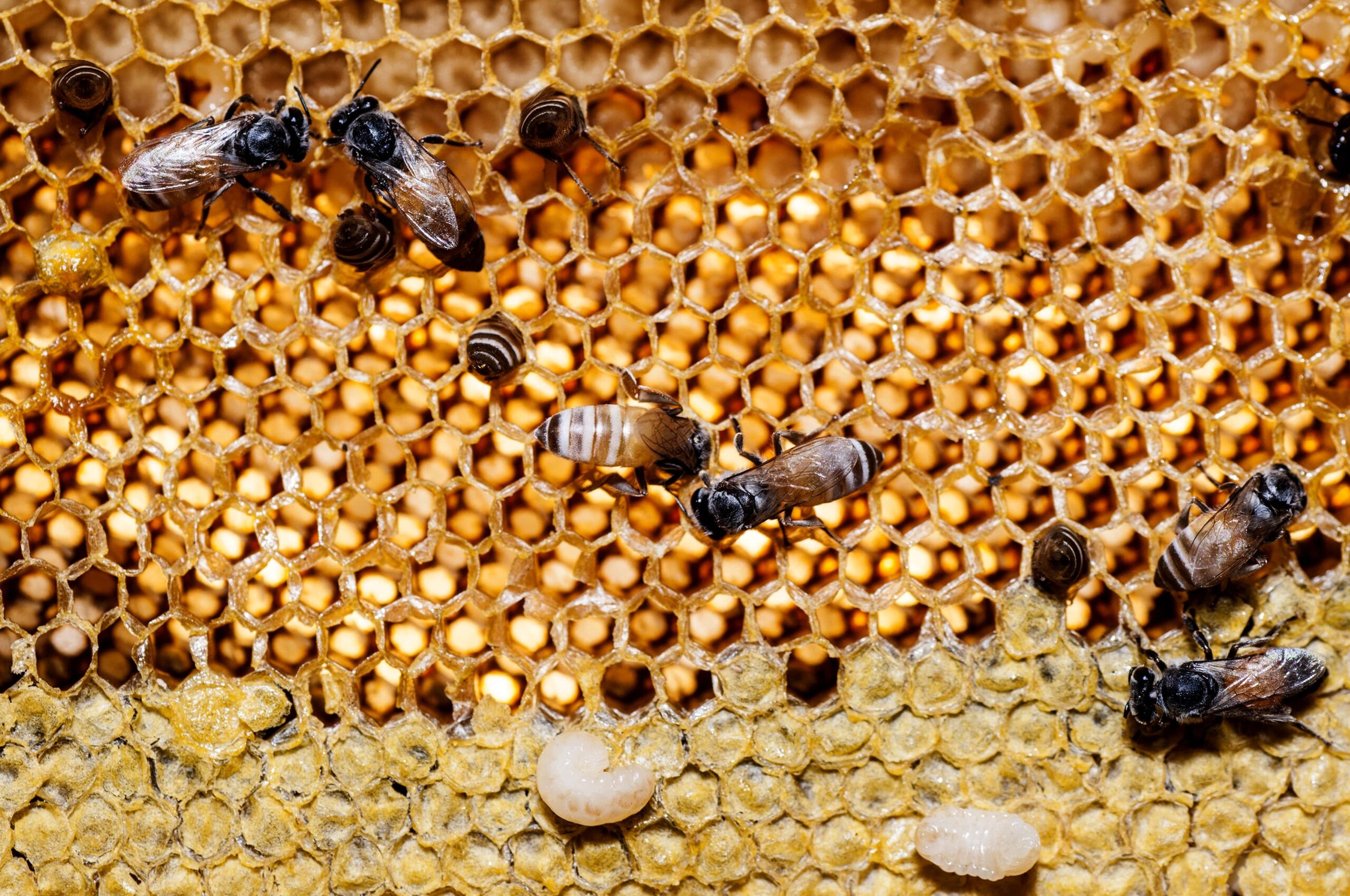Welcome to the world of bees and their ingenious creation, the honeycomb. Honey bees, captivating humans for centuries, construct intricate hexagonal cells called honeycomb. This article explores how bees make honeycombs. Covering their anatomy, behavior, and the significance of this marvel in bee society.
Fascinating world of bees and honeycomb
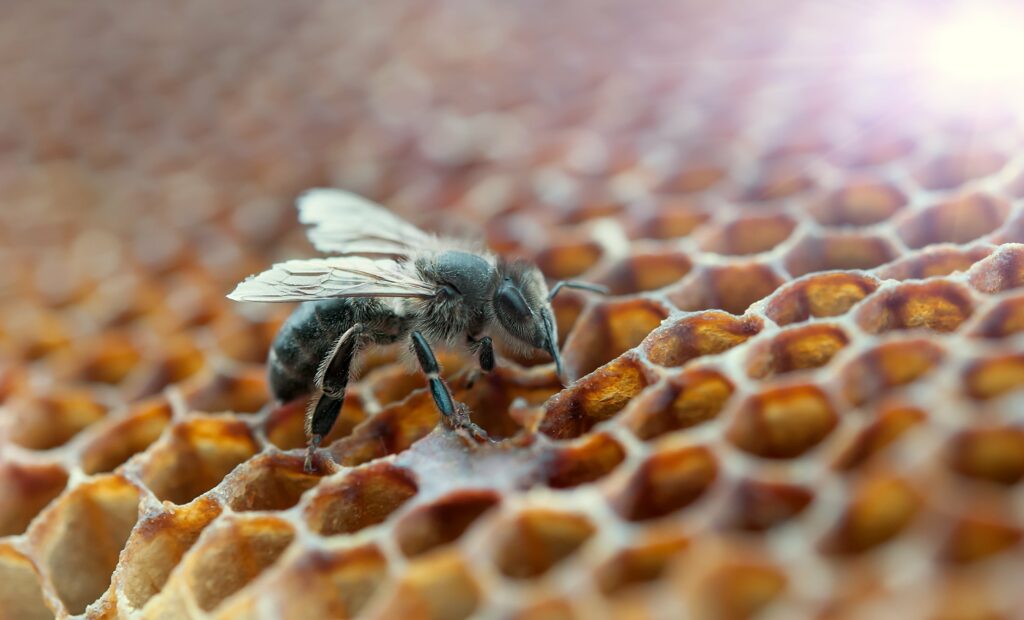
Bees, especially honey bees, are incredibly intriguing creatures. They live in colonies consisting of thousands of individuals. These individuals work together tirelessly to build and maintain their hives.
The awe-inspiring part is their special glands, called wax glands. These are located on the surface area of their abdomen. These glands produce wax scales. This is a secretion material that they chew and shape into hexagonal cells.
Why hexagons? Well, it turns out that nature’s best mathematicians are none other than bees!
Honeycomb cells being in hexagonal shapes can serve several purposes. Firstly, this shape allows for an efficient use of space within the hive.
Every millimeter is crucial for storing resources. These include pollen, nectar, or developing baby bee brood cells. Choosing hexagons over squares or triangles is a smart compromise. Resulting in balancing strength and material usage.
Importance of honeycomb in bee society
Honeycomb is not just a random structure within a beehive. Honeycombs play a vital role in sustaining the whole colony’s survival. The comb cells serve different purposes based on their specific shapes and sizes. Worker bees construct specialized brood cells. This is where eggs are laid by the queen bee and larvae develop into adult bees.
These carefully designed chambers provide optimal conditions for healthy growth. Additionally, honeycomb cells also act as storage units.
Bees diligently collect nectar from flowers and convert it into honey. They store this honey within the honeycomb. This raw honey is the primary food source for bees during colder months when flowers are scarce.
The comb cells store pollen, a vital resource for bees. This offers them protein and essential nutrients. Exploring how bees create honeycomb enhances our admiration for these creatures. It also unveils the intricate beauty of nature’s design.
The Intricate World of Bees: Anatomy and Behavior
Overview of Different Types of Bees in a Colony
Within drone cells of a bee colony, there are three essential types of bees: the queen, drones, and worker bees. The queen bee is the matriarch. She is responsible for laying eggs to sustain the colony’s population.
Drones are male bees whose primary purpose is to mate with virgin queens. However, they come from other colonies and harvest honey from them. However, the true marvels of honeycomb construction rely on worker bees.
Role of Worker Bees in Honeycomb Construction
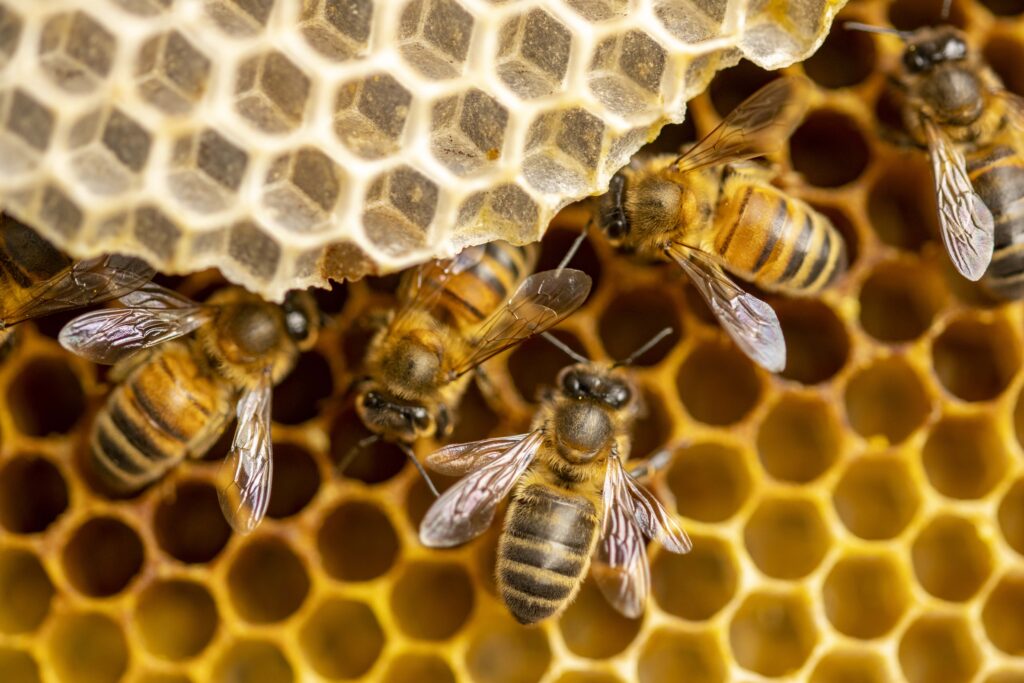
Worker bees are crucial in building honeycomb within a bee colony. These diligent females perform many tasks. These include collecting nectar and turning it into honey. Later on, producing wax scales, and shaping them into honeycomb cells hexagonal cells.
Their tireless efforts ensure not only the survival but also the success of other bees in using honey resources in their hive. Worker bees have specialized glands that secrete wax required for honeycomb construction.
Special glands on their abdomen produce small wax scales used as building materials. These tiny scales are produced at an astonishing rate. It takes around 1 kg (2 pounds) of honey to produce just 8 grams (0.28 ounces) of wax!
Once secreted by these extraordinary bees, each scale is meticulously chewed and shaped. This is done using mandibles until they become pliable. The choice of hexagonal structures for the entire honeycomb only adds to the fascination.
While other shapes could be used different shapes for honeycomb cells, nature favors hexagons. This can be due to their efficient use of space. Hexagons allow perfect packing without wasted space, tessellating seamlessly like puzzle pieces.
This geometric advantage ensures efficient use of wax and honey without unnecessary voids. Hexagonal wax store honey cells are more stable and less prone to collapsing. This is due to surface tension between wax and honey, unlike other shapes.
Worker bees instinctively understand the engineering required to make an effective honeycomb. They use measurements of the cell shapes, walls, angles, edges, and sizes in honeycomb construction. Their remarkable anatomy and behavior significantly contribute to the ingenious construction of honeycomb.
Specialized glands, rapid wax scale production, and instinctual hexagonal knowledge. These are all the skills used that make worker bees the architects of this miraculous feat. In the next section, we’ll explore how they collect nectar from flowers and transform it into honey.
Into the Heart of Honey Making: Nectar Collection and Conversion
The Honeycomb Construction Process
Collecting Nectar and Pollen from Flowers: Nature’s Sweet Bounty

Diligent bees search for the best floral treasures to meet their colony’s needs. Honeycomb construction starts with collecting nectar and pollen from flowers. This becomes essential for this creation. Bees use their proboscis to extract nectar from deep within blossoms.
With agile precision, they unfurl their proboscis, delicately probing each petal’s nectar-laden reservoirs. This viscous liquid, rich in nutrients and sugars, becomes the essence of honey.
Pollen Collection: Hairs as Nature’s Baskets

Gathering nectar is crucial for honey production. Bees also collect pollen for the growing hive. Female worker bees have special hairs called pollen baskets or corbiculae.
These clever structures work like tiny cargo holds. These are where bees store pollen pellets gathered during their flower visits. When landing on a flower’s anthers, they use movements to dislodge pollen onto these hairs.
Conversion of Nectar into Honey: A Metabolic Alchemy

Once bees return to the hive with nectar and pollen, the transformation begins. Turning nectar into honey starts with the breakdown by female worker bees’ digestive systems.
These hardworking creatures make enzymes. Enzymes change complex sugars in nectar. They make them simpler and easier to digest. This process boosts nectar’s nutrition and starts turning it into honey.
Viscosity: The Art of Water Evaporation

Bees make honey using a careful evaporation process. Worker bees spread broken-down nectar in hexagonal cells of the honeycomb.
With expert precision, they fan their wings and create a gentle breeze within the hive. This airflow accelerates water evaporation from the nectar, gradually reducing its water content.
Maintain exact humidity for perfect liquid gold transformation. Water evaporates, thickening honey like magic until it’s a sweet syrup we love.
Wax Production: A Worker Bee’s Renaissance
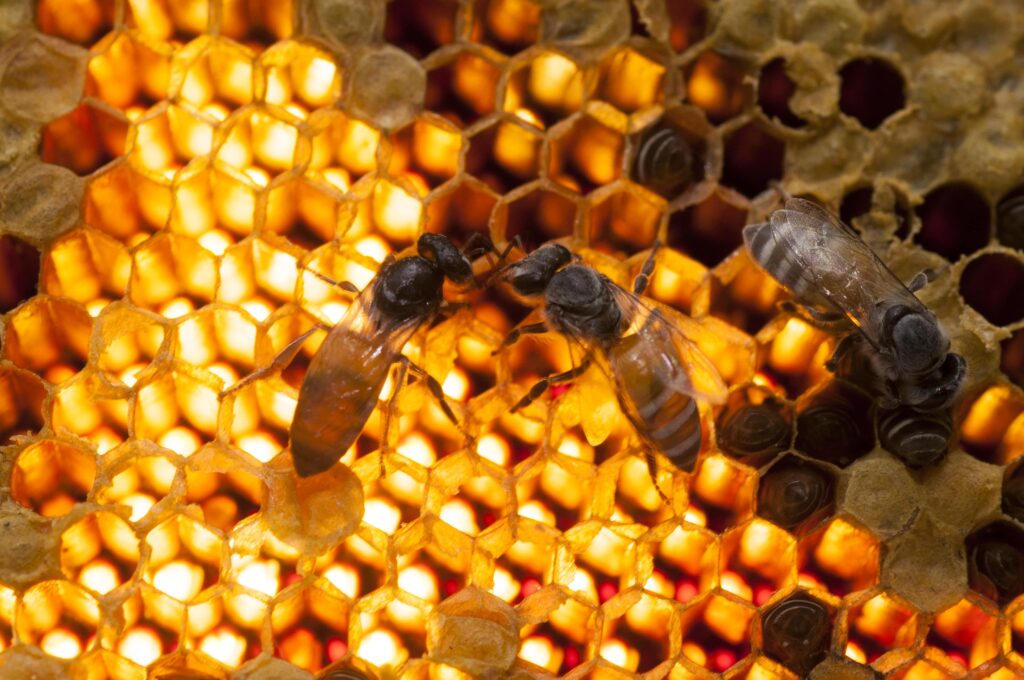
Nature shows off in wax production within honey bee and colonies. Female worker bees have special wax glands under their abdomen.
These special glands release tiny wax scales, creating delicate flakes full of potential. Worker bees chew the scales with a creative focus. Much like an artist molding clay or a sculptor shaping marble, brimming with purpose.
Building Hexagonal Cells: Geometry’s Masterpiece
Worker bees mold malleable wax flakes into hexagonal cells, a masterpiece of ingenuity. This architectural marvel serves as pollen storage. Crafted through diligent craftsmanship and instincts passed down through generations. Each hexagonal cell takes the form of an equilateral triangle, abutting two others. This helps in maximizing space utilization while minimizing material usage. Bees efficiently create countless hexagonal cells in their abode. This ensures no waste of honey or wax. This process showcases the remarkable efficiency ingrained in bee behavior. A testament to their evolutionary journey and cooperative existence.
Architectural Marvel: Honeycomb Structure
Hexagonal Shape Advantages
In honeycomb construction, the hexagon is a marvel of nature with its six equal sides and angles. Bees benefit from this shape to eat honeycomb, as it allows efficient use of space. Hexagonal designs offers advantages, making it a smart choice when building their comb.
Bees in hives face limited space. Hexagonal cells maximize storage while minimizing waste. Unlike circular cells or other shapes, hexagons fit tightly together, like puzzle pieces. This tight fit ensures efficient use of space within the hive. It also allows bees to make the most of their surroundings.
Efficient space use helps bees store more honey in a compact hive. The hexagonal shape also minimizes material usage for storing honey in storage.
Bees are skilled architects who know saving resources matters. They build honeycomb with hexagonal cells. They find a balance between strong structure and using materials wisely.
Neighboring queen cells share walls, reducing wax needed for partitions. Bees use resources efficiently, saving energy for vital tasks in their colony. This smart resource use lets them focus on crucial activities. This contributes to the overall efficiency of their hive.
Construction Technique for Uniform Cells
Bees use an impressive technique to build honeycomb cells. They showcase remarkable abilities and instincts. Worker bees coordinate closely to construct each honeycomb cell with mathematical precision.
Female worker bees start by secreting wax scales from glands on their abdomen. They then chew and shape these wax scales into tiny building blocks. This forms the basis for honeycomb construction.
Bees use precision to mold wax scales into perfect hexagons. Individual cells may vary slightly in shape and size based on hive needs. Overall consistency first cell, is achieved through instinctive behavior.
Bees follow instinctive rules passed down through generations. This ensures honeycomb cells have similar angles and edges. Such behavior not only makes the cells uniform but also maintains the integrity of the comb.
The hexagonal pattern in honeycomb shows nature’s beauty and honey bees’ ingenuity. It optimizes space and minimizes material use, making an efficient, structurally sound comb. This is a testament to the remarkable abilities of honey bees.
Specialized cells within the honeycomb
Worker cells for brood rearing
The honeycomb is a complex world with specialized cells for specific purposes. In this environment, the worker bee cell stands out, playing a vital role in the task of brood rearing.
Female worker bees build cells for eggs, larvae, and pupae. The size of these cells varies based on the developmental stage they accommodate.
Young bees need varying space as they grow. Worker bees instinctively build larger cells for growing larvae. They build smaller ones for eggs and pupae in their life cycle.
Size differences ensure each stage has enough room to develop comfortably. This prevents wasted space in other shape of the honeycomb and maximizes resource usage efficiency.
Honeybees use a clever strategy to protect their young. Each brood cell has multiple hexagonal tubes stacked together. This design creates an extra layer of insulation for the delicate occupants. This ensures optimal protection.
This design regulates temperature and humidity. This supports the growing brood with enhanced structural integrity. It’s fascinating to consider how these tiny creatures use techniques within their hives.
Storage cells for nectar, pollen, and honey

Nature’s pantry, the honeycomb, has worker cells for brood and storage cells. These cells are for nectar, pollen, and honey. Bees collect these treasures from flowers. Like worker cells, storage cells vary in shape and size for different content needs.
Nectar storage cells, larger for ample nectar, sit near honeycomb edges. This strategic placement eases access for bees returning from foraging expeditions.
Pollen storage cells serve as vital food sources for bees and their young. Bees diligently pack these cells with protein-rich pollen collected from flowers. This ensures a nutritious supply for their hive.
We enjoy honeycomb storage cells, the hive’s true delicacy. Special hexagonal comb cells get sealed with wax caps when filled with ripened honey.
Making honey involves a few different steps. Including breaking down complex sugars in nectar, then evaporating to reduce water content. This results in thick, sweet raw honey. The sealed honeycomb preserves the honey. This acts as a defensive barrier against invaders, keeping it pure until needed.
Honeycomb isn’t just a beautiful creation—it’s an organized marvel. Each cell has a specific purpose, nurturing future generations or storing nature’s bounty.
Remarkable bees make intricate design choices for efficient space and resource use. They provide protection and sustenance for the hive community. This showcases nature’s brilliance and emphasizes why bees are extraordinary creatures.
Honeycomb Maintenance and Repair
Cleaning: Keeping the Home Neat and Tidy
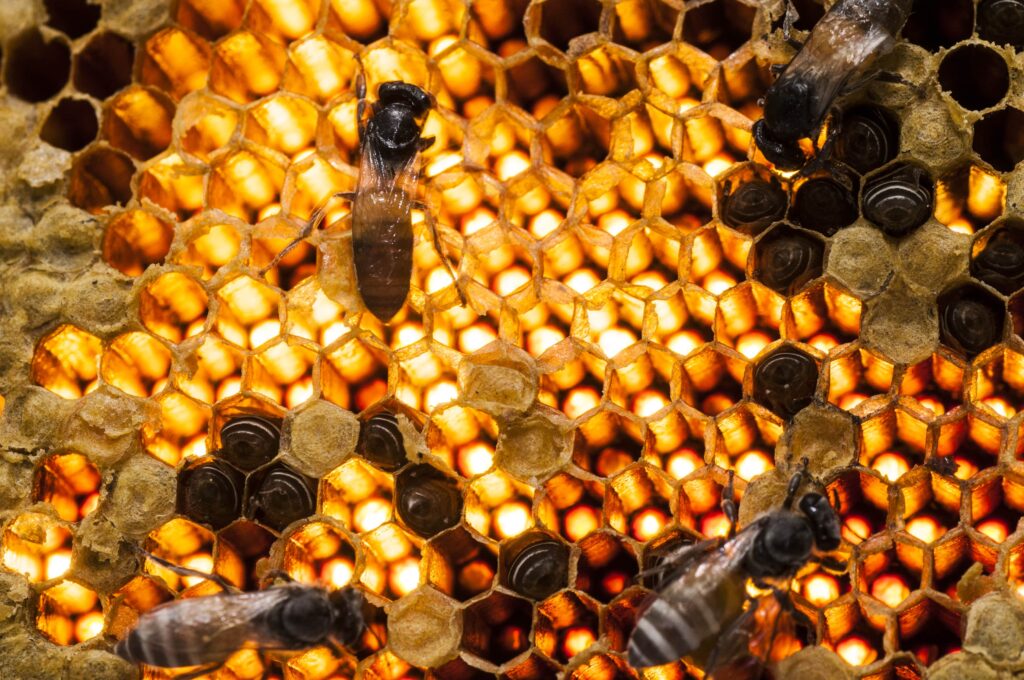
In the bustling world of honey bees, a clean home is crucial. Like humans, bees take cleanliness seriously. Worker bees perform cleaning duties within the hive, ensuring a healthy environment. This commitment showcases their remarkable social organization.
Cleaning activities in the hive involve several tasks. First and foremost, bees remove any dead or diseased individuals from the colony. They do this to prevent the spread of infections.
They also clear away debris such as pollen grains that have fallen onto the comb surface. This often occurs during foraging activities. Fastidious workers use legs and adapted mouthparts to scrub dirt from each cell. This ensures a pristine living space.
Worker bees ventilate the hive by fanning their wings. This maintains optimal temperature and humidity. The airflow prevents moisture build-up, avoiding potential mold or mildew growth.
Conclusion: The Delicate Balance of Nature’s Architects
Exploring how honeybees gather nectar and make honeycomb reveals their remarkable skills. They gather nectar and pollen, and produce wax scales for precise comb construction. Each step serves a purpose in creating a harmonious abode for their colony.
Hexagonal honeycomb cells are elegant, using space efficiently and minimizing waste. Worker bees instinctively ensure uniformity. This aids in effective brood rearing and honey storage, showcasing their remarkable abilities. This results in a harmonious and efficient hive.
Observing nature’s builders reveals exceptional craftsmanship and provides insights into sustainable design. The intricate network of cells showcases both functionality and beauty. This is a testament to nature’s ability to inspire structures in human engineering.
Next time you see a honeybee with tiny wax scales, admire their architectural prowess. The dance between bees and honeycomb showcases nature’s balance. This leaves us in awe of the wonders beneath our feet.
Eliminate bee problems with D-Termination: Las Vegas’ top-notch pest control service!

If you’re grappling with bee issues on your Las Vegas property, trust D-Termination for professional assistance. Our skilled team specializes in eradicating bee infestations, bringing back comfort and tranquility to your space. Bid goodbye to bees—choose D-Termination for efficient pest control today!
Contact us at 702-919-6310 or visit dtermination.com to schedule your bee control service and regain control of your space from these bothersome insects.
Frequently Asked Questions:
Honeycomb is formed by bees using beeswax secreted from their bodies.
Bees make perfect honeycombs by secreting beeswax and shaping it with their mandibles.
Bees can build comb rapidly, often completing a honeycomb in a matter of hours or days.
Bees construct honeycombs using beeswax, a substance produced by special glands in their bodies.

